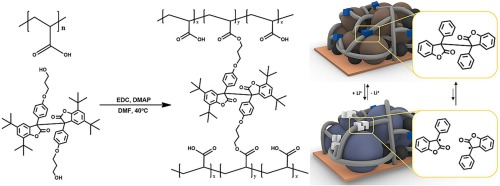A high-performance self-healing polymer binder for Si anodes based on dynamic carbon radicals in cross-linked poly(acrylic acid)
- 글번호
- 377738
- 작성일
- 2023-11-24
- 수정일
- 2023-11-24
- 작성자
- 화학과
- 조회수
- 1102
지도교수 : 김태현 (연구실홈페이지)
참여학생 : 장원석(석사, 1저자), 김상욱(석사과정, 공동1저자), 강유미(석사과정, 공동저자)
Chemical Engineering Journal, 2023, 469, 143949 (링크)
Silicon (Si), which exhibits high theoretical capacity, is a promising material for high energy density anode material in Lithium Ion Batteries (LIBs) because it is abundant in nature, inexpensive, and eco-friendly. However, Si has excessive volume expansion with charge and discharge cycles, resulting in reduced capacity reversibility and collapsing electrode structures. To overcome this limitation, polymer binders equipped with various functions have been used to improve the electrochemical performance of Si. The present study developed a self-healing cross-linked poly(acrylic acid) (PAA) binder for Si anodes functionalized with diarylbibenzofuranone (DABBF), which exhibits self-healing from reversible C-C bonding and the debonding of dynamic carbon radicals. When applied to Si anodes, the PAA-based binder functionalized with DABBF formed a three-dimensional network, stabilizing the Si structure and achieving improved adhesion and mechanical properties. Its self-healing performance enabled the Si anodes to exhibit stable capacity retention. In addition, the adhesion performance and mechanical properties of Si anodes were higher when DABBF-functionalized PAA was used as a binder. At a current density of 0.5 C, a high initial coulombic efficiency (ICE) of 77.89% was achieved, and after 500 cycles, the capacity remained high, 1774.45 mAh g−1. A novel cross-linked polymer binder with self-healing ability was successfully developed for the first time using dynamic carbon radicals, and its excellent electrochemical performance significantly improved the stability of Si anodes.

- 첨부파일
- 첨부파일이(가) 없습니다.